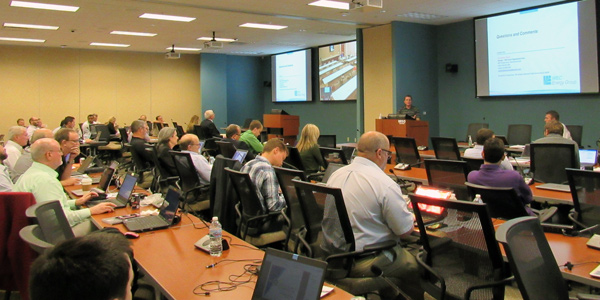By Amanda Durish Cook
MISO’s plan to create external resource zones in its annual capacity auction isn’t detailed enough on several fronts, FERC told the RTO on Wednesday.
Commission staff issued MISO a deficiency notice explaining the proposal lacks sufficient detail about the reliability concerns that spurred it, the concept of border external resources, and how pseudo-tied resources and coordinating members’ resources will factor into the proposal (ER18-1173).

MISO Resource Adequacy Subcommittee in 2017 | © RTO Insider
MISO filed the plan in late March after three years of stakeholder meetings in its Resource Adequacy Subcommittee. It would create external resource zones by 2019 for MISO’s annual capacity auction, based on existing neighboring balancing authority area boundaries. External zones would not have capacity import limits, planning reserve margin requirements or local clearing requirements.
Resources in BAAs that border either MISO Midwest or South would clear at two different prices based on subregional unconstrained auction clearing prices, while those in BAAs that border both MISO areas — including Tennessee Valley Authority, SPP, Associated Electric Cooperative Inc. and Southwestern Power Administration — would receive a blended price.

| MISO
In cases of auction price separation, the RTO would distribute historical supply arrangement credits from excess auction revenues as a refund to external resources with long-term and consistently used historical supply agreements. The proposal would also establish new zonal capacity export limits in time for the 2019/20 planning year auction. (See MISO Closing in on External Capacity Zones.)
In its deficiency letter, FERC asked MISO, among other questions:
- Why it thinks that its current practice of giving external resources capacity credit in the local resource zone where its firm transmission service crosses into the footprint has the potential to cause reliability concerns;
- How it will reconcile its current Tariff definition of local clearing requirement — defined as the minimum amount of unforced capacity physically located with a local zone — with its proposal to allow certain external resources to contribute to a local resource zone’s local clearing requirement;
- If it will count pseudo-tied resources as external resources;
- How it differentiates a “border external resource” — defined in the proposal as resources with direct electrical connections to the RTO but located in another BAA — from all other external resources;
- How border external resources and coordinating owner external resources can be used to alleviate transmission constraints and address other reliability concerns for local resource zones;
- How it plans to model external resources and how coordinating owner and border external resources will impact capacity import and export limits;
- What physical and operational standards a coordinating owner external resource must meet to qualify for capacity credit in a local resource zone. FERC also asked MISO to identify any other coordinating members besides Manitoba Hydro, its sole listed coordinating owner;
- If its proposed historical supply arrangement credits will be distributed to resources offered into the Planning Resource Auction, resources included in a fixed resource adequacy plan or both; and
- How much estimated capacity would qualify for historical supply arrangement credits. FERC also asked MISO to describe scenarios in which the credits might not be fully funded.
FERC also ordered MISO to list all resources that would receive border external resource designation, their unforced capacity values and the local resource zones they border. The RTO previously said it identified about 3.8 GW of capacity from potential border external resources.
Finally, the commission said MISO must compare in writing the operational control it has over Manitoba Hydro’s resources versus other external resources, including Exelon’s Byron Generating Station, Duke Energy Indiana’s Madison Generating Station, WPPI Energy’s Nelson Energy Center and any resources with firm transmission service over a direct current line, such as the Grain Belt Express Clean Line.




